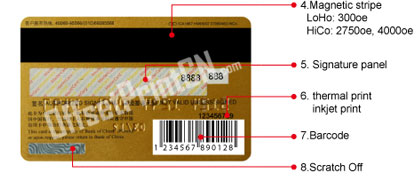 Applications for RFID
Applications for RFID  Electronic Product Code
Electronic Product Code  ISO 14443A
ISO 14443A ISO 14443B
ISO 14443B ISO 15693
ISO 15693 Magnetic stripe
Magnetic stripe  Memory Cards
Memory Cards  Potential uses for RFID
Potential uses for RFID  RFID Frequency
RFID Frequency Smart card
Smart card Types of RFID Tags
Types of RFID Tags
 What is a SAM?
What is a SAM?  What is a semiconductor?
What is a semiconductor?  What is a SIM?
What is a SIM?  What is a smart card module?
What is a smart card module? What is meant by “contactless” smart card?
What is meant by “contactless” smart card?  What is a wafer?
What is a wafer?  What is an IC?
What is an IC? What is Dual Interface?
What is Dual Interface?  What is EMV?
What is EMV?  What is GSM?
What is GSM?  What is MIFARE?
What is MIFARE?  What is RFID?
What is RFID? What is UIM?
What is UIM?
Customization Options


Before printing, please send us the artwork in the format illustrated in the following table. Then we'll check and send an e-proof back for your confirmation. Real samples making on request.
Note: Please include all the fonts used in your artwork. If you don't want us to make any change to your artwork file, please convert all font types to curves / outlines.
1. Hole punching
2. Embossing: It is the process of creating a three-dimensional image or design in paper and other ductile materials. It is typically accomplished with a combination of heat and pressure on the paper. This is achieved by using a metal die (female) usually made of brass and a counter die (male) that fit together and actually squeeze the fibers of the substrate.
Hot-stamping: It is defined as a dry printing process, which uses controlled heat, pressure, and precision timing to transfer a color pigment from foil to surfaces of varied shapes and materials. This process forms a permanent bond between the part and the foil, and creates a dry print.
3. Hologram: A three dimensional image; unlike regular images which are usually two dimensional, a three dimensional image or hologram, appears to "pop out" of the media which it is printed on or illuminated from. Hologram images are usually created by using a single laser beam which is split and splashed onto the object and finally onto the film.
4. Magnetic stripe: A stripe of magnetic information that is affixed to the back of a plastic credit or debit card. This stripe contains customer and account information that is required to complete electronic financial transactions. The physical and magnetic characteristics of this stripe are specified in the International Organization for Standardization standards 7810, 7811 and 7813.
5.Signature panel: the area of an identification card in which the bearer enters his signature (defined in ISO 7810).
6. Inkjet printing: A group of dot matrix printing technologies, such as thermal, piezo, phase change and continuous flow in which electrically charged droplets of ink are projected onto the paper or canvas.
Thermal printing: An printing method that uses heat and pressure to melt a coloured wax foil onto self adhesive vinyl.7. Barcode: It is an optical machine-readable representation of data. Originally, bar codes represented data in the widths (lines) and the spacings of parallel lines and may be referred to as linear or 1D (1 dimensional) barcodes or symbologies. But they also come in patterns of squares, dots, hexagons and other geometric patterns within images termed 2D (2 dimensional) matrix codes or symbologies. In spite of there being no bars, 2D systems are generally referred to as barcodes as well.
8.Scratch off: A scratch off card (also called a scratch off, scratch ticket, scratcher, scratchie, scratch-it, scratch game, scratch-and-win or instant game) is a small token, usually made of cardboard, where one or more areas contain concealed information: they are covered by a substance (usually latex) that cannot be seen through, but can be scratched off.
Others
Offset printing: It is a commonly used printing technique where the inked image is transferred (or "offset") from a plate to a rubber blanket, then to the printing surface. When used in combination with the lithographic process, which is based on the repulsion of oil and water, the offset technique employs a flat (planographic) image carrier on which the image to be printed obtains ink from ink rollers, while the non-printing area attracts a water-based film (called "fountain solution"), keeping the non-printing areas ink-free.
Silkscreen printing: It is a printing technique that uses a woven mesh to support an ink blocking stencil. The attached stencil forms open areas of mesh that transfer ink as a sharp-edged image onto a substrate. A roller or squeegee is moved across the screen stencil forcing or pumping ink past the threads of the woven mesh in the open areas. Silkscreen printing is also a stencil method of print making in which a design is imposed on a screen of silk or other fine mesh, with blank areas coated with an impermeable substance, and ink is forced through the mesh onto the printing surface. It is also known as "silk screening" or "serigraphy".
